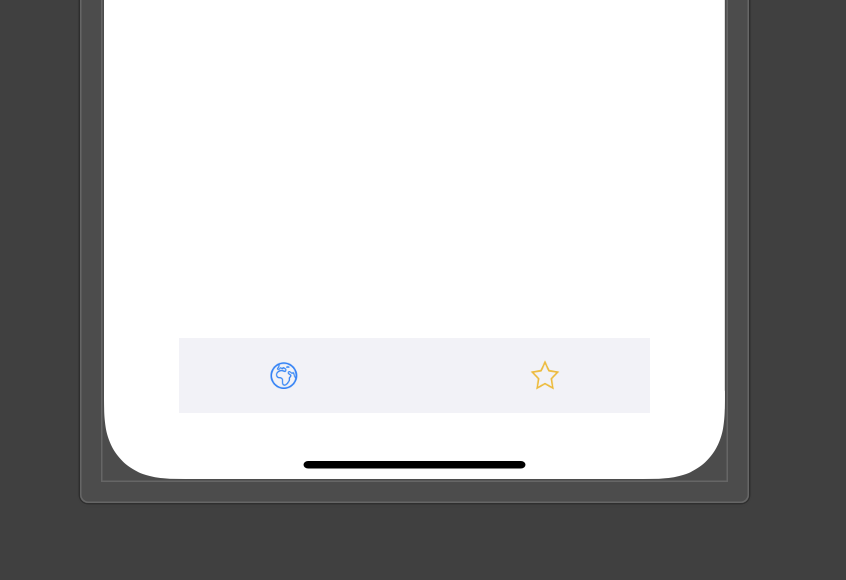我没有使用故事板。
我做了customTabBarView。(我在视图上添加了 2 个按钮)。
我连接了具有相同功能的按钮并给按钮一个tag值。
当我按下第一个按钮或按下任何按钮时,如何打开 ViewController?
当我点击第一个按钮时,我收到了这个错误。
错误:
*** Terminating app due to uncaught exception 'NSUnknownKeyException', reason: '[<NSObject 0x28184c020> setValue:forUndefinedKey:]: this class is not key value coding-compliant for the key countryListTableView.'
terminating with uncaught exception of type NSException
场景委托:
guard let windowScene = (scene as? UIWindowScene) else { return }
let countryRouter = TabBarViewController()
let window = UIWindow(windowScene: windowScene)
window.rootViewController = countryRouter
self.window = window
window.makeKeyAndVisible()
视图控制器国家串列:
class ViewControllerCountryList: UIViewController, CountryListModule.View {
.
.
.
}
选项卡按钮:
class TabBarViewController: UIViewController {
@IBOutlet weak var contentView: UIView!
@IBOutlet weak var tabBarView: UIView!
override func viewDidLoad() {
super.viewDidLoad()
designableTabBarView()
}
private func designableTabBarView() {
tabBarView.layer.cornerRadius = tabBarView.frame.size.height / 3
tabBarView.clipsToBounds = true
}
@IBAction func onClickTabBarButton(_ sender: UIButton) {
switch sender.tag {
case 1:
let nib = UINib(nibName: "ViewControllerCountryList", bundle: nil)
guard let countryListVC = nib.instantiate(withOwner: nil, options: nil).first as? ViewControllerCountryList else { return }
self.addChild(countryListVC)
countryList.didMove(toParent: self)
default:
break
}
}
}

uj5u.com热心网友回复:
错误是说你已经加载了 aNSObject并试图使用它,就好像它有一个countryListTableView成员一样。这表明您的 xib 中的第一项不是ViewControllerCountryList.
如果查看 xib 无法找到明显的解决方案,我建议通过检查加载 xib 实际回传的内容进行除错(而不是立即尝试强制转换)。
uj5u.com热心网友回复:
使用instantiate(withOwner:options:)并不真正适合您的任务。
更好的方法是使用init(nibName:bundle:).
这个扩展将它包装成一个简单的单行呼叫:
extension UIViewController {
static func loadFromNib() -> Self {
func instantiateFromNib<T: UIViewController>() -> T {
return T.init(nibName: String(describing: T.self), bundle: nil)
}
return instantiateFromNib()
}
}
有了它,您现在可以执行以下操作:
let countryListVC = ViewControllerCountryList.loadFromNib()
对于您的“自定义选项卡”布局,请查看以下内容:
class TabBarViewController: UIViewController {
@IBOutlet weak var contentView: UIView!
@IBOutlet weak var tabBarView: UIView!
// keep references to the loaded view controllers
var countryListVC: ViewControllerCountryList!
var someOtherVC: SomeOtherViewController!
override func viewDidLoad() {
super.viewDidLoad()
designableTabBarView()
}
private func designableTabBarView() {
tabBarView.layer.cornerRadius = tabBarView.frame.size.height / 3
tabBarView.clipsToBounds = true
}
@IBAction func onClickTabBarButton(_ sender: UIButton) {
switch sender.tag {
case 1:
// remove other VC view from content view
if someOtherVC != nil {
someOtherVC.view.removeFromSuperview()
}
// if we haven't loaded ViewControllerCountryList yet
if countryListVC == nil {
countryListVC = ViewControllerCountryList.loadFromNib()
self.addChild(countryListVC)
contentView.addSubview(countryListVC.view)
countryListVC.didMove(toParent: self)
}
// add ViewControllerCountryList view to contentView
contentView.addSubview(countryListVC.view)
countryListVC.view.frame = contentView.bounds
countryListVC.view.autoresizingMask = [.flexibleWidth, .flexibleHeight]
case 2:
// remove country list VC view from content view
if countryListVC != nil {
countryListVC.view.removeFromSuperview()
}
// if we haven't loaded SomeOtherViewController yet
if someOtherVC == nil {
someOtherVC = SomeOtherViewController.loadFromNib()
self.addChild(someOtherVC)
contentView.addSubview(someOtherVC.view)
someOtherVC.didMove(toParent: self)
}
// add SomeOtherViewController view to contentView
contentView.addSubview(someOtherVC.view)
someOtherVC.view.frame = contentView.bounds
someOtherVC.view.autoresizingMask = [.flexibleWidth, .flexibleHeight]
default:
break
}
}
}













0 评论